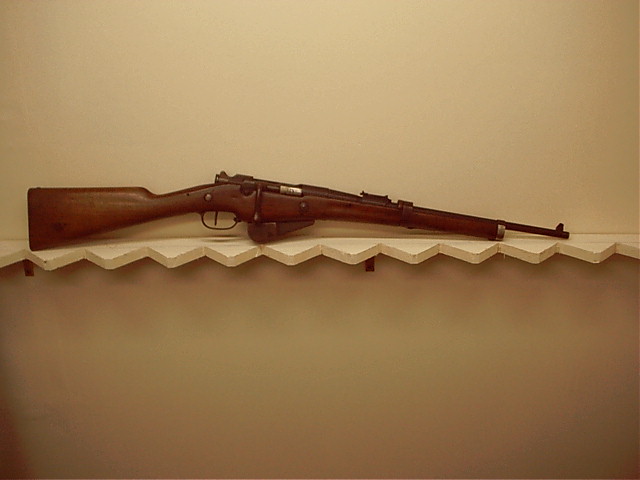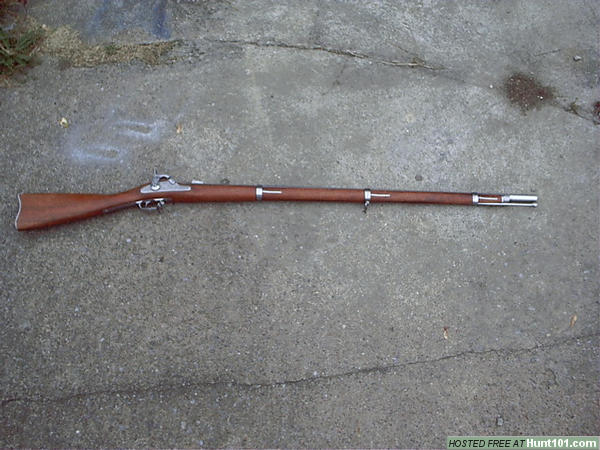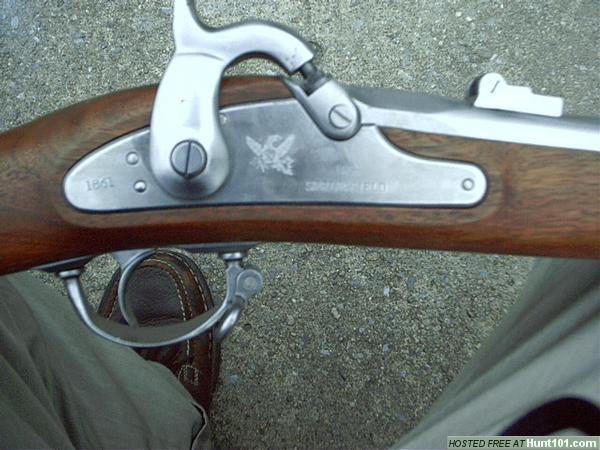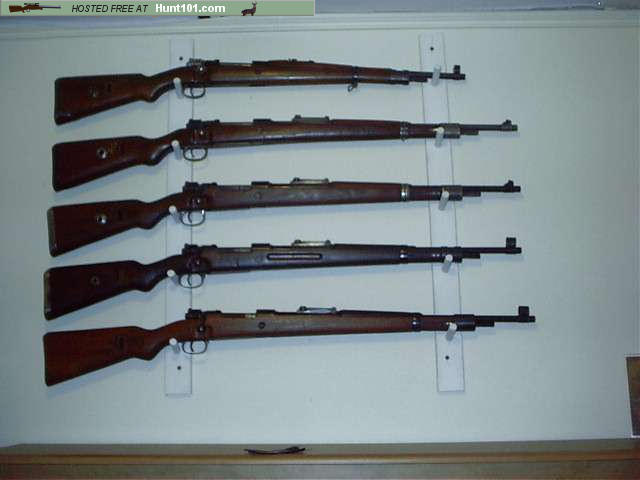
The 74/80 French Gras
This Particular Gras Rifle is a 1874/80, made at St. Etienne in 1879. I make 11x59R French Gras brass to fire this rifle from 348 Winchester factory brass. The rifle has a near perfect bore, and it quite pleasant to shoot. Using 340 grn lead bullets, recoil is easily tolerable,
The German Model 1871 Mauser
The I.G.(German abbreviation for Infantry Rifle) 71 was first developed by Paul Mauser in 1871, The Mauser model 1871 would have been a single hot bolt action rifle, which fired a bullet of 11.15 millimeters in diameter to a velocity of about 1450 ft/sec. This rifle was first adopted by Prussia in 1871 under Kaiser Wilhelm
The I.G. 71/84 is a variation of the I.G. 71, The /84 denotes that this rifle was made to accept an 8 shot tubular magazine. The rifle pictured above is a 71/84 made at the Spandau Armory in 1888. This particular rifle was a recent importation of rifles from South America. These rifles were sold off as surplus in the early 20th century by Germany, apparently they were sealed into a cave and forgotten about for nearly one hundred years. My rifle was reconditioned by Gibbs Rifle company, the exterior metal has some slight pitting, but the bore is near perfect. I have also shot this rifle using Bertram Brass, and it performs excellent.
The Karabiner 71 pictured is my favorite rifle in my collection. It is in near mint condition, with the exception that someone shortened the stock on it, making it look more like a Trapdoor Springfield carbine. Every piece of the rifle is serial numbered to the gun, even the screws and the springs, and on this rifle , they all match. This rifle still retains the original unit markings on its buttplate. The buttplate bear the following designation 6.D.5.11, which means that this rifle was issued to the 6th Dragoon regiment, 5th company, 11th rifle.
The Dutch Gew. 71/88 Beaumont
In the late nineteenth century, an arms race had begun brewing in Europe. In 1871, Prussia adopted their newly designed bolt action center fire infantry rifle, the Dutch followed suit the same year adopting their Gewer 1871. The Dutch Gewer is a bolt action rifle, which was loosely copied from the French 1866 Chassepot Needle Rifle. This is clearly evident when comparing stocks, barrel bands, nose caps, and some other furniture. The Dutch Gew 1871 also incorporated some unique features of it own. For example, the Dutch Gew 1871 has a bolt handle which is comprised to two halves, the halves are joined together, leaving a hollow space. The Dutch thought that this would be a perfect spot to house the main spring to the rifle. Thus the main spring to the rifle is tucked away in the bolt knob.
The rifle pictured is a Dutch Gewer 71/88, which retains is similar to the rifle above, with the exception that in 1888 the gun was modified to accept a 5 round box magazine. The pictured rifle was manufactured in 1876, and is the nicest example of a Dutch Beaumont that I have ever seen. I have not yet fired this rifle yet, a good winter project for me this year is to make some 11x50R Beaumont rounds. I will update this site in the spring to let you know how the Beaumont performs.
The German Gewer 1888 Commission Rifle
The Development of smokeless powder by the French, and the adoption of the 1886 Lebel Rifle threw Germany into a frenzy. Germany could not allow their neighbor and bitter enemy, France have far superior arms. In 1887 German gave a commission of men the task of developing a rifle to replace the I.G, 71/84. This new rifle was required to fire a smokeless powder cartridge. By 1888, the commission had adopted the Gewer 1888 rifle, and it became known as the " Commission Rifle" The commission rifle has many unique features, such as a barrel jacket, instead of a handguard. This barrel jacket would protect the soldier's hands from touching a hot barrel. They chose to use a barrel jacket because the commission had decided that metal would not warp in wet condition, which could adversely effect the accuracy of the rifle. This barrel jacked posed problems that were not foreseen by the commission. This barrel jacket held moisture under it, rusting the barrel. A severe problem in battlefield conditions. The clip of the Gewer 1888 was severely flawed. This clip could not be topped off during battle, and it allowed dirt to enter the action of the rifle, causing jamming problems.
The Gewer 1888 was a dismal failure of a rifle. Paul Mauser was quite upset that his home country did not ask him to design their new rifle. Paul had vowed that he could design a much better rifle that the Gewer 1888, and by 1891 he had accomplished this. Through several modifications in 1893, 1895, and 1898, the 1891 action was modified, and the magazine was changed form a single stack to a double stack. By 1898, Germany felt their Gewer 1888 had been hopelessly outclassed by Paul Mauser's design, and decided to re-arm their forces with Gewer 1898's
The Gew 1888 pictured above was made at Spandau in 1890. This rifle was also one of Gibbs recent importations from South America. I have not shot this rifle yet, as I am in need of some .318 diameter bullets. These Gewer 1888's should not be fired under any circumstances with modern 8mm Mauser ammunition. The bore diameter of these Gewer 1888's are smaller than modern rifles. In addition the action of the Gewer 1888 is much weaker than modern mausers. These combinations, fired with modern 8mm mauser ammunition will result in serious injury or death
More to come Soon !!!!
The 1916 Berthier Carbine
Below is a picture of my French Berthier carbine.

I scored this rifle quite a while back for around $80 , I grabbed it as it was a very interesting addition to my collection. This rifle was actually a 1916 Berthier rifle, that was cut down over the year to Mousqueton de Artillerie M.16 Transforme 1927 configuration. This particular one seems to be put together form a lot of spare parts. Evidently the French loved to do that. Although this is the most common type of Berthier Carbine encountered, I have never seen another one.
This weapon fires the first smokeless powder cartridge, the 8mm Lebel. If you ever come across one of these rifles, never fire any Balle N surplus ammunition in it unless you verify that the reciver has the N mark over the chamber. Firing Balle N in a Berthier meant for Balle M or D will cause the gun to explode, as the bore diameter was changed. I handload for mine, I form the brass out of .348 Winchester brass. This gun has quite a bit of recoil, as it is very lightweight.
I recently Picked up a Replica of a U.S. Model 1861 Springfield Rifle


The 1861 springfied was the main rifle used by both sides during the Civil War. It is a 58 caliber musket, and it has a percussion lock. After the Civil War the US goverment converted many of these rifles to the "Trapdoor Springfield" configuration. The Trapdoor Springfield was assembled by inserting a 50 caliber liner into 58 caliber barrel. The lock was then converted centerfire breechloading.
My collection of World War 2 German K98 Mausers

Some other great sites to visit!!!
The Curio & Relics Firearms Forum
Gibbs Rifle Company
Midway Usa website